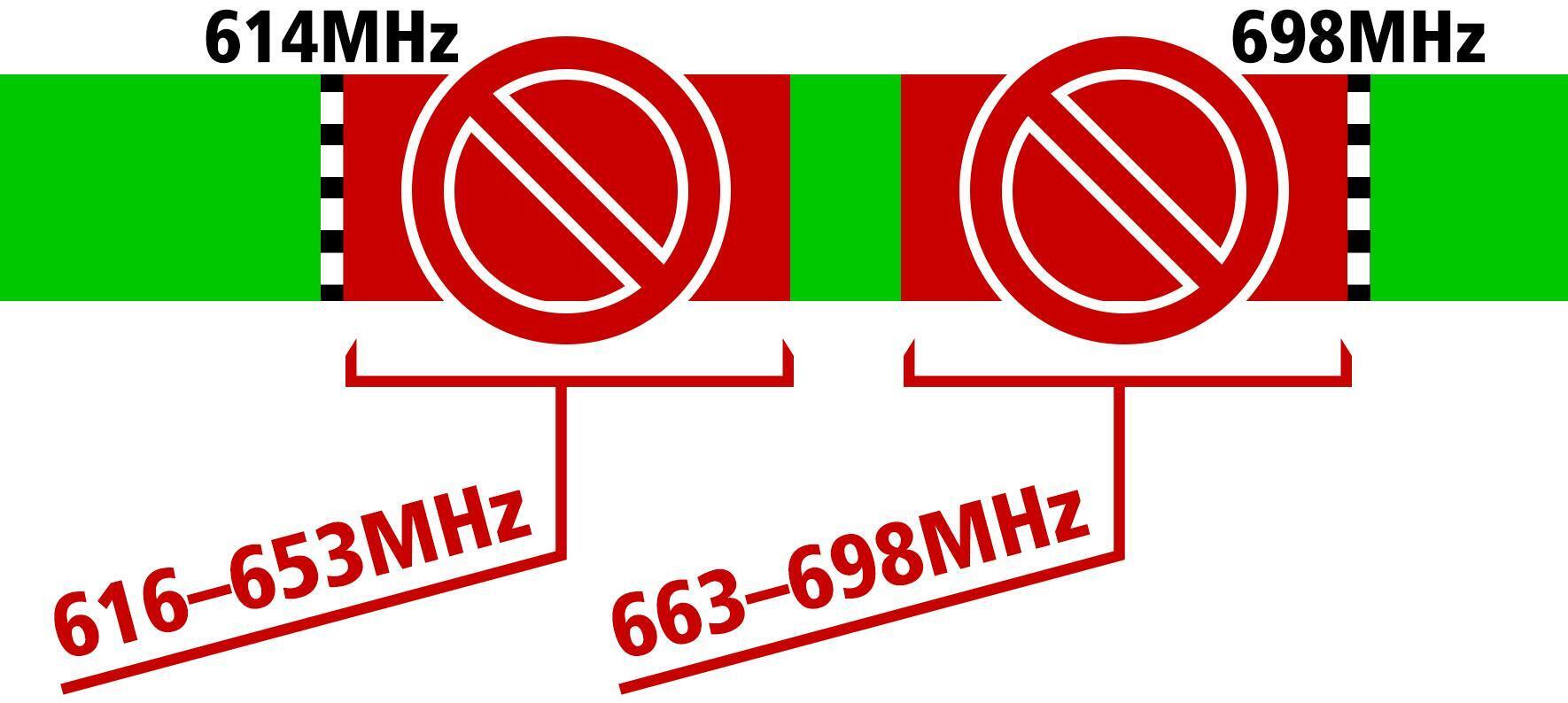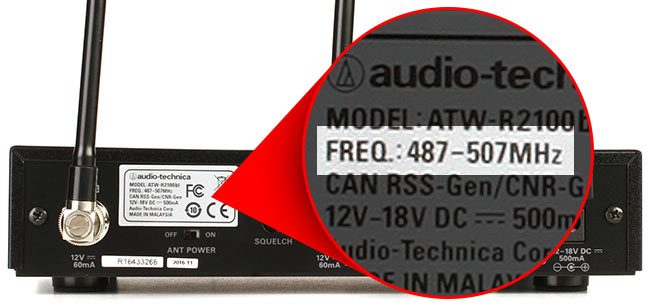
The US government authorized the Federal Communications Commission (FCC) to auction off a portion of the wireless spectrum (TV bands) to make that spectrum available for wireless broadband and cell phone uses. These frequencies are where many wireless mics and in-ear monitor systems have been operating for years. So what does this auction mean to you, the wireless mic user? While this is an enormously complex and technical issue, here are some simple answers to the questions we are hearing from our wireless customers.
When is the auction happening?
The auction concluded in March 2017, and there’s a 39-month transition that will be complete by 2020.
What does this mean to me as a wireless user?
Wireless systems operating in the red bands of frequencies shown below will need to be replaced/retired within the next 39 months or sooner depending on the purchaser’s transition rate, to be in compliance with the law.

These frequencies in red above will be affected by the FCC’s 600MHz spectrum auction
What specific frequencies are affected?
The frequencies are 616–653MHz and 663–698MHz. To ensure that our customers are making wise investments in wireless, Sweetwater is no longer selling systems that operate in this band.
How do I find the frequencies where my wireless system is operating?
All wireless systems display the frequency band on the receiving unit or on the mic or body pack, so check there to see what frequencies your wireless systems operate on. Here’s where to look.



What action do I need to take right now?
If you have wireless systems operating in the affected frequencies, then we recommend you start planning and budgeting to replace them. Sweetwater has a wide range of options at various price points that will serve your needs well. Call your Sweetwater Sales Engineer at (800) 222-4700 if you have any questions.
NOTE: Shure Wireless Rebate
Shure has announced its 600MHz Wireless Rebate, which allows you to trade in your eligible 600MHz wireless system for a rebate toward your purchase of a new system. The rebate program runs until October 31, 2018. Call your Sweetwater Sales Engineer for more details.
NOTE: Sennheiser Wireless Rebate
Sennheiser has announced a 600MHz Wireless Rebate, which allows you to buy a new system and return an eligible 600MHz wireless system for a rebate. The rebate program runs until June 30, 2018. Call your Sweetwater Sales Engineer for more details.
NOTE: Audio-Technica Wireless Trade-in Rebate
Audio-Technica has announced a 600MHz Wireless Rebate, which allows you to buy a new system and return an eligible 600MHz wireless system for a rebate. The rebate program runs through March 31, 2019. Call your Sweetwater Sales Engineer for more details.
Read on if you are more technically inclined. Here are the details — the kind that only engineers want to know.
For the past several years, wireless microphone and in-ear monitor (IEM) systems users have been full of questions about the upcoming spectrum auctions and their impact on existing wireless systems. In 2012, the FCC was authorized by Congress to auction off portions of the wireless spectrum “to align the use of broadcast spectrum with 21st century consumer demands for video and broadband services.” Portions of the spectrum in the UHF TV band currently used by many wireless mic systems are being reallocated for other purposes and were recently sold off to the highest bidders. While the UHF Incentive Auction of spectrum has been an ongoing process for the past five years, the final stage just concluded in March 2017, and we now know exactly what frequencies will be off limits for wireless users.
New uses for TV band spectrum that were first contemplated during the transition to digital over-the-air broadcasting have been accelerated with the explosive growth of mobile consumer devices such as smart phones and tablet computers. According to the FCC’s site, “by making valuable ‘low-band’ airwaves available for wireless broadband, the incentive auction will benefit consumers by easing congestion on wireless networks, laying the groundwork for ‘fifth generation’ (5G) wireless services and applications, and spurring job creation and economic growth.”*
For people who have wireless microphones and personal in-ear monitors (IEMs) that operate in the auctioned UHF spectrum (616–653MHz and 663–698MHz), those systems will need to be retired in a maximum of 39 months after the FCC’s issuance of the Channel Reassignment Public Notice (which was released April 13, 2017). Users may continue to use those systems for the time being, but if the new licensee (who just purchased the spectrum in those bands) begins using their purchased spectrum, the wireless user in that frequency band must change frequencies to avoid interfering. Users should be aware that the spectrum in certain cities is higher priority than in other cities, so major markets will likely be the first to begin use of those bands, which translates into buying replacement microphone systems sooner than later. These days, it’s more important than ever to choose wireless systems that are frequency agile, and follow best practices when it comes to things like frequency coordination, antenna choice and placement, and antenna distribution.
Major wireless mic manufacturers such as Shure and Sennheiser have been making plans for this transition for years. Since January 2015, Shure has been discontinuing systems that operate in the 600MHz range and developing new systems that operate in VHF, UHF, 900MHz, and 2.4GHz to give options to wireless customers of all types. At Sweetwater, we don’t currently offer wireless systems that are operating in the 600MHz range.
While your system(s) will likely continue to operate unimpeded for now, it’s definitely time to assess which systems will need to be replaced. This transition period will allow you time to plan and budget for new systems. There is no need to immediately replace all 616–653MHz and 663–698MHz systems, but it is definitely time to start shopping. If you own an affected system, Sweetwater’s Sales Engineers are ready to answer your questions and can steer you to great replacement systems. Understand that there is no way for them to know at this time when the new spectrum owners will begin using the frequency bands where your current wireless system is operating. To be safe, systems in these bands should be replaced soon to avoid potential interference with their useful operation. As the new licensees roll out their systems, a wireless mic might work properly one week and experience interference the next.
Sweetwater has a wide range of wireless mic and instrument options to fit all budgets. Each user’s needs may vary depending on variables like the number of units needed to operate in a single space, channel counts, and distance from transmitter to receiver. To make sure you get the best system for your application, call us. We can answer all your questions and get you the system that best matches your needs.
To avoid future concerns regarding regulatory changes to the spectrum in which your wireless systems operate, the best options may be in the unlicensed ISM (Industrial, Scientific, and Medical Radio) bands (902–928MHz in the US and 2.4GHz globally). Although maximum channel counts may be limited compared to some UHF systems, wireless microphones operating in the unlicensed bands can be a good option for smaller venues. It is important to note that the 2.4GHz band is commonly used for Wi-Fi, which should be carefully coordinated with wireless microphone systems operating in the same venue. The 900MHz ISM spectrum is also occupied by consumer devices such as cordless phones, baby monitors, and other household wireless devices, but interference can in most cases be mitigated by proper setup and operation of the wireless microphone system.
Existing wireless systems in the affected 616–653MHz and 663–698MHz spectrum will need to be permanently retired in the US within 39 months of the FCC’s post-Incentive Auction Channel Reassignment Public Notice. For churches or people who have connections in foreign countries (such as churches on mission fields), these systems may be legal and extremely useful in other countries and have an extended life there. However, you should always consult the local spectrum authority for the proper frequency ranges and output power requirements for wireless microphones in a particular country.
At Sweetwater, we work hard every day to stay on top of technological advances that will impact and enhance the technology needs of our customers. As standards change, you can always trust Sweetwater to be your trusted and knowledgeable source. If you have any questions about wireless mics or in-ear monitor systems or any other music technology, your Sales Engineer is just a phone call away. Give us a call — we’re here for you.
Thanks to Mark Brunner and Sean Bowman from Shure for their authoritative input.
* https://www.fcc.gov/about-fcc/fcc-initiatives/incentive-auctions



